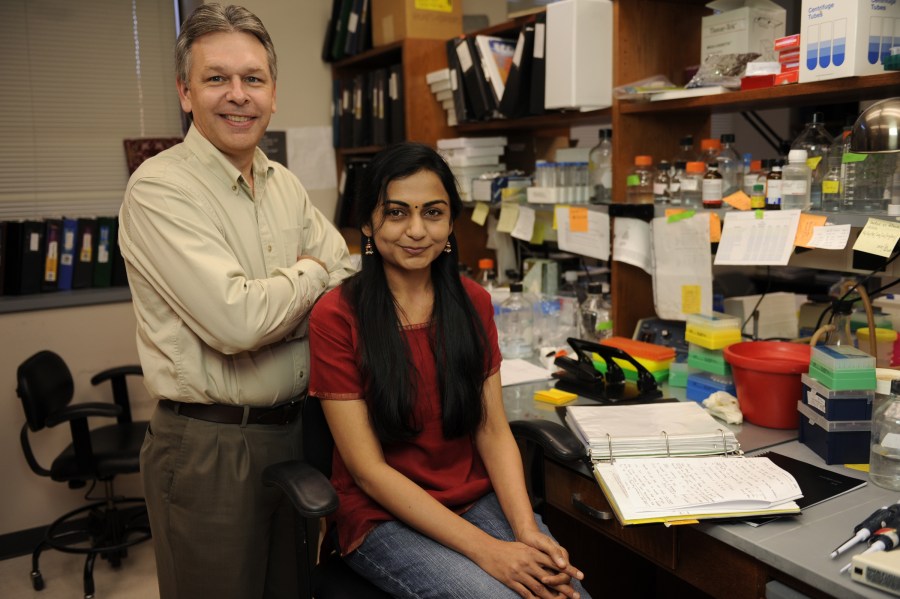
Scott Hiebert, Ph.D., Srividya Bhaskara, Ph.D., and colleagues are studying how novel cancer drugs work. (photo by John Russell)
Study sheds light on how new cancer drugs work
Proteins called HDACs are the targets of a new class of anti-cancer compounds (HDAC inhibitors). How these compounds kill tumor cells — and the potential side effects of such drugs — are still open questions.
Scott Hiebert, Ph.D., and colleagues at Vanderbilt-Ingram Cancer Center have now discovered that mice missing a particular HDAC (pronounced h-dack) in the liver have disrupted chromatin — the compacted form of DNA in the cell nucleus — and develop liver cancer. The team's findings, reported in the Nov. 16 issue of Cancer Cell, offer insights into HDAC inhibitor function and suggest ways to use the compounds more effectively.
“We think that HDAC inhibitors are causing DNA damage to cells that are rapidly growing, like cancer cells, and that they really don't affect cells that aren't dividing,” said Hiebert, Ingram Professor of Cancer Research and professor of Biochemistry.
The cancer-causing potential of the compounds isn't a serious concern, Hiebert said, because the drugs act for only a short time (compared to the permanent loss of HDAC function in the mouse model).
HDACs regulate DNA accessibility. In the cell nucleus, DNA wraps around proteins called histones into the tightly coiled form called chromatin.
“If you stretched out all the DNA in a single cell and laid it end to end, it would be about three feet long,” Hiebert said. “And that DNA has to be packaged into the very small space of the nucleus. It's a really fascinating physical problem for the cell to compact all of its DNA into the nucleus, and then to be able to replicate it and copy parts of it for protein production.”
The cell makes DNA available for copying, at least in part, by modifying the histone proteins — adding or removing chemical bits. The addition of chemical “acetyl” groups to histones opens sections of the DNA, making it available to replication, transcription (for protein production), and DNA repair machinery. Removal of the acetyl groups by HDACs (histone deacetylases) returns the DNA to a compacted — closed for business — state.
To explore the roles of individual HDACs (there are at least 17 such proteins), Hiebert's team used genetic strategies in mice to eliminate the HDAC3 gene. They found previously that mice without HDAC3 die before birth. In the current studies, they eliminated HDAC3 specifically in the liver and discovered that the mice develop liver cancer.
They also found that in cells missing HDAC3, the DNA was “completely open,” Hiebert said. The chromatin no longer existed in its compact/closed form.
“Eliminating HDAC3 had a global effect on chromatin, which was completely unexpected.
“We think that removal of HDAC3 deregulates chromatin structure, which then causes DNA damage, genomic instability, and ultimately, cancer. It looks like the target of HDAC inhibitors may really be chromatin structure, but we're still at a very early stage of sorting out how these drugs are working.”
Hiebert said he is still surprised that eliminating one of the HDACs had such a big effect.
“All of the research until now has associated HDAC3 with the regulation of specific genes, not bulk chromatin, so we were really kind of shocked by this global effect on chromatin.”
HDAC3, the investigators concluded, is essential for the maintenance of chromatin structure and genome stability.
It's important to understand the function of other individual HDACs to design better and more specific cancer therapeutics, Hiebert added. The two recently approved HDAC inhibitors, vorinostat (Zolinza) and romidepsin (Istodax), block more than one type of HDAC.
Srividya Bhaskara, Ph.D., a postdoctoral fellow in Biochemistry, is the first author of the Cancer Cell paper. The research was supported by the T.J. Martell Foundation, the Robert J. Kleberg Jr. and Helen C. Kleberg Foundation, and the National Institutes of Health.













